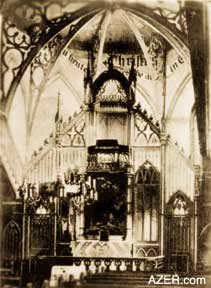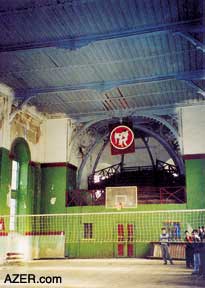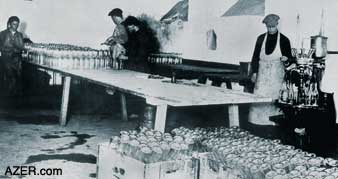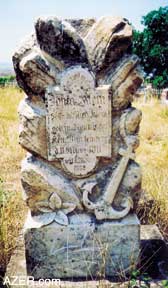|

Summer 2004 (12.2)
Pages
70-75
Wine and Wagons
Helenendorf:
Azerbaijan's First German Settlement
by Jacqueline Grewlich-Suchet
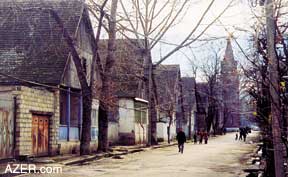  Left: The main street of Khanlar which was once called
Helenendorf and the settlement of German immigrants. The houses
were built in the mid-1800s. Photo: Jacqueline Grewlich Left: The main street of Khanlar which was once called
Helenendorf and the settlement of German immigrants. The houses
were built in the mid-1800s. Photo: Jacqueline Grewlich
Below: Typical architecture of the homes hand
made by settlers who came to Helenendorf from Germany. in the
early 19th century.
But about 180 years
ago, another exiled population had chosen to settle down in this
fertile region. Curiously, they came from Germany.
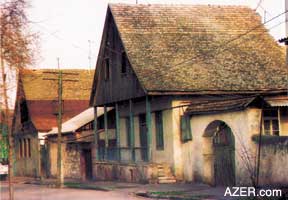  Again,
the culprit was war, which had left their community desperately
struggling to find ways to survive. Again,
the culprit was war, which had left their community desperately
struggling to find ways to survive.
Jacqueline Grewlich-Suchet, wife of Klaus Grewlich, the German
Ambassador to Azerbaijan, writes about some of the history of
these first Germans who settled in Azerbaijan. She gathered this
information from residents living in the town of Khanlar itself
and from historians of Azerbaijan's Academy of Science.
In 1909 in his book, "A
German Colony in the Caucasus", Count Schweinitz wrote a
description about a German settlement called Helenendorf [now
Khanlar]. Here's the picture he painted of the little town in
the northwestern region of Azerbaijan nearly 100 years ago.
Above: (Left) Interior of the German Church
in Helenendorf (now Khanlar) in the northwestern region of Azerbaijan.
The church was built in the mid-1950s. Photo: Azerbaijan National
Photo Archives.
Right: During the Soviet period, the interior
was converted into a sports center where basketball and volleyball
were played. These days, the governor of the region has designated
the building as a museum. Perhaps in the future, it may reconverted
to a Community Assembly building. Photo: Jacqueline Grewlich.
"From every corner of Helenendorf, there's a wonderful view
of the snow-covered mountains that forms the magnificent background
of this beautiful village. Towards the south, you can see the
Small Caucasus Mountains, towards the north lies the mighty chain
of the North Caucasus. To the east lies cultivated land as far
as the horizon.
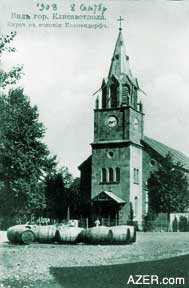  Left: The German Church at Helenendorf where wine-making
was one of the main agricultural activities. The church was built
in 1857-1859. Photo: Azerbaijan National Photo Archives. Left: The German Church at Helenendorf where wine-making
was one of the main agricultural activities. The church was built
in 1857-1859. Photo: Azerbaijan National Photo Archives.
"When you walk along the western - most street of Helenendorf
- the Talstrasse - you can enjoy the view of a gorge and then
of a hill with graves from the past, dating back a few thousand
years. There is little water in the Ganja River now and seeing
this small stream, it's hard to believe that once it swept away
an impressive stone bridge. The entire valley is covered with
vineyards - a beautiful scene, even in winter.
Two buildings can be seen in the gorge in the area of Helenendorf,
one of which is a modern mill supplied by electrical power owned
by the Vohrer brothers; the other, an electric power station
built by the Baku branch of the Berlin Electricity Company.
"The bazaars and open workshops, which are so characteristic
of the Orient, are missing from Helenendorf. Nor can the agricultural
character of the locale be felt because walls block the views
of the farmyards with their equipment, tools and compost heaps.
There is a multi-colored Oriental hustle on the streets caused
by the passers-by and the inhabitants of numerous tribes."
On Easter Tuesday in 1819, nearly a year and a half after leaving
their native land, German settlers from Schwaben [Stuttgart,
Ulm and Reutlingen in Southern Germany] arrived in a valley region
in what is present-day Azerbaijan. They finally made the decision
to settle and try to make this place their new home.
It was Russian Czar Alexander I who bestowed the name "Helenendorf"
upon the German settlement, in memory of his beloved sister Helen
Paulovna who had died at an early age. Today, the town is known
as Khanlar or "place of the khans".
Above: Top: Bottling Factory for Wine in the
Helendorf region, late 1800s and early 1900s. The wine was from
the Helendorf region which was cultivated by the Germans who
had settled there. Photo: Azerbaijan National Photo Archives.
Below: Grave markers mark the German graves
in the cemetery at Helenendorf in northwestern Azerbaijan. The
town is now called Khanlar.
Czar Alexander enforced the Immigration Regulations of Empress
Catherine. The government required that newcomers should be good
craftsmen or farmers, specializing either in wine growing, silk
production or cattle breeding. Also they should marry and have
children.
Why Leave Germany?
But why had the Germans left their homeland in the first place?
Actually, there were various reasons that influenced their decision
to emigrate from Germany and eventually settle in the Caucasus.
The primary factor, most likely, was the dire political and economic
situation in the southern German provinces as a consequence of
the Napoleonic wars [1789-1815].
At that time, many Germans migrated to North America. Others
held religious convictions that the anti-Christ would soon appear
and that the place of salvation was to be found east of Mount
Ararat [in Turkey, purportedly where Noah's ark rested after
the Great Flood]. These ideas were propagated by Pietist Bengel
and Jung-Stilling.
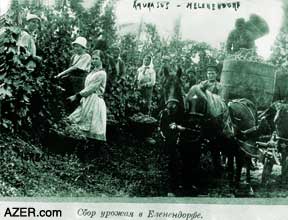  Left: Vineyards in Helenendorf that were cultivated
by the Germans who fled the aftermath of the Napoleonic wars
and settled in northwestern Azerbaijan. Photo: Azerbaijan National
Photo Archives. Left: Vineyards in Helenendorf that were cultivated
by the Germans who fled the aftermath of the Napoleonic wars
and settled in northwestern Azerbaijan. Photo: Azerbaijan National
Photo Archives.
The role of Juliane von Krüdener also is believed to have
figured into the decision. She is said to have influenced the
Russian czar, whom she met in Heilbronn, the heart of Schwaben
land, in seeking permission to allow the Svebians to emigrate.
This occurred during the years immediately following the Napoleon
War, which ended in 1815.
In those early days when the Svebians first settled in the Helenendorf
region, they had no source of income and, consequently, were
deeply indebted to the crown. They had already sold the possessions
that they had carried with them to make the journey to Odessa
[now Ukraine]. Then came the march from Odessa to the Caucasus.
The Svebians finally arrived on the steppe of Khanlar, totally
empty-handed: no money, no equipment, no seeds, not even the
necessary clothing to warm themselves in the foothills of the
Caucasus mountains. It's likely they were close to despair. However,
it was their belief in God that kept them going. The moment they
realized that there was no way to return, they settled in and
determined to fight for their survival with courage and contempt
for death.
Survivors
It's true that the Svebians were saved from hunger because neighbors
came to their rescue, and the Russian crown offered them loans.
The settlers' workload was extremely difficult. They had to cope
with bad weather, extreme heat, unhealthy accommodations and
poor nutrition, which made them susceptible to serious diseases.
Only 118 families were left remaining in the province. Other
families died out entirely, including those with names such as
Aichler (from Tubingen), Hartenstein (from Balingen), Kies (from
Degerloch), Epp, Votteler, Hummel, Vohrer and Klein (from Reutlingen).
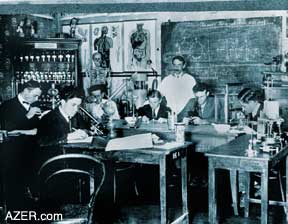  Left: Science classes in Helenendorf. Prior to World
War II, when all Germans were exiled to Siberia. Photo: Azerbaijan
National Photo Archives. Left: Science classes in Helenendorf. Prior to World
War II, when all Germans were exiled to Siberia. Photo: Azerbaijan
National Photo Archives.
Of course, one should not forget the other ravages that these
early settlers had to deal with - the assaults and war (1826),
the ravaging plague (1829), cholera (1830) and the severe frigid,
icy winter that destroyed spring crops and vineyards (1831).
Afterwards, there was a calmer period for the Helenendorf settlers.
In fact, the Russo-Turkish War (1855) with its troop mobilization
enabled the people of Helenendorf to make considerable profit
from the sale of their agricultural products. Furthermore, they
began to set up businesses driving wagons that they had constructed
themselves. Many people earned their living transporting goods.
Despite the Russo-Turkish war and the serious unrest along the
Caucasian border regions, the people of Helenendorf succeeded
in constructing a church in 1857-1859. The architect was Eichler.
A chronicle of that period described the significance for the
community in building the church: "The calm self-confidence
expressed by this decision" positively affected the reputation
of the town, as well as the security of the people of Helenendorf
and their neighbors. Eventually, they were able to pay off their
debt to the Russian crown. In addition, the construction of the
Caucasian railway in 1883 through the region greatly improved
their opportunities to sell their agricultural products.
Vohrer Brothers
The story of the Vohrer Brothers is impressive. In 1846 Christopher
Vohrer planted a vineyard on one hectare of his land. He paid
particular attention in selecting the type of grapes to cultivate,
taking into account the conditions of climate and soil. Obviously,
he was successful because in 1856 the French silk traders praised
Vorher's wine while passing through the nearby town of Shaki.
Christopher Vohrer had worked as a shoemaker, postman and wagon
maker before fully directing his attention on his vineyards in
1860.
As an entrepreneur, Vohrer had founded a joint stock company
as early as 1862. In 1870, he created a family company known
as "Christopher Vohrer and Brothers". Systematically,
he began to expand his property by purchasing additional land.
In 1892, the 65-year-old Christopher passed the company on to
his sons. The successful company continued its activities under
the name Vohrer Brothers, which sold 350,000 liters of wine annually.
By the time World War II broke out, the company also owned several
brandy, cognac breweries, wine distilleries, a water mill, a
brewery and a stud farm.
The Hummels
By 1895 the Hummel family had established a crafts company. They
also planted vineyards and set up a wine cellar to distribute
wines from Baku to Tbilisi. In 1895 a cognac factory was built
in Helenendorf. The Baku-Tbilisi Railway further facilitated
their commercial success. They even used their wine-making knowledge
to help control pests. Large wood and stone barrels which were
lined with glass as well as press and cooling systems also led
to the improvement in the taste of the wine. Press residues were
even sold as dyes for printing.
At the beginning of World War I, the Helenendorf enterprises
accounted for between 3 to 15 percent of grapes, wine and cognac
production in the entire Transcaucasus and Russia, according
to Eva Maria Auch in her book, "Oil and Wine in the Caucasus",
2001.
The Azerbaijani government supported the work of German National
Committee in the fields of education, culture and religion. German
intellectuals in Azerbaijan cooperated with their Azerbaijani
colleagues in establishing high schools, the oil industry and
medical institutions.
Disaster Strikes
However it wasn't long until the repercussions from Hitler's
attack on Russia in 1941 were felt by the Azerbaijani Germans
living in Helenendorf. Anyone of German origin was immediately
identified and deported en masse. On October 17, 1941, a decree
led to the confiscation of all their homes, giving them all to
the government. The only proof of the many years of their hard
labor was a receipt from the local Soviet authorities and the
meagre possessions that they were able to carry in their hands.
The deportation was carried out on October 18 and 19. And so
these German settlers were hauled away by truck to Ganja, a city
in north central Azerbaijan. From there, this human freight was
sent on to Baku by rail, then further east via the Caspian Sea
to Krasnovodsk in Turkmenistan.
At that point, a long freight train journey awaited the exiled
settlers. It consisted of a 5,000 km journey eastward via Ashgabad,
Samarkand to Tashkent, then further north to Orenburg (Ural Mountains)
and from there 1,000 km eastwards to Omsk (Siberia). The final
stretch was 500 km south to Zelinograd (Kazakhstan). Understandably,
many of settlers did not survive the gruelling trip, and died
en route, according to Ulrich Mohl who wrote, "The Schwabish
Pioneer Spirit in the Caucasus - the Russian German Colony of
Helenendorf," 2002/3.
Relationships Today
Azerbaijan has not forgotten the Germans nor their successful
wine growers, wagon constructors and architects. Nor have the
names of prominent designers who built prominent buildings in
Baku under the auspices of Oil Barons been forgotten either.
Their names include such illustrious architects as von der Nonne,
A.W. Eichler, I.W. Edel and F.A. Lemkul. Other landmarks which
have a German imprint on them exist in downtown Baku, such as
the Lutheran church.
The complex adjacent to the church, known as the Kappellhaus
was renovated in 1999 by German companies and has since become
the center of Azerbaijani-German cultural exchange. These days,
many families who trace their origins to Germany no longer speak
the German language. For that reason, the German Embassy supports
many musical performances at the Kapellhaus, music being a universal
language that can be understood and appreciated by all.
Scattered throughout the country and capital are graves of Germans
and German prisoners of war - another stark reminder of history
but which reflects the friendship that has long existed in the
community here in Azerbaijan.
Helenendorf Today
The Schwaben houses which are located in the heart of Azerbaijan
in Khanlar / Helenendorf are now part of Azerbaijan's cultural
heritage. The vibrant culture of the people who settled Helenendorf
can still be felt today especially when you visit Victor Klein's
house. Klein, now in his late 60s, is the last surviving German
in Azerbaijan. In 1941, as a mere child of 5 years old, he was
not forced to leave the country along with the other members
in the community as his father had been killed and the child
was declared to be Russian.
One of the distinctive characteristics of Helenendorf is the
hand-made furniture. Victor loved his mother so much that when
she passed away, he left everything in the house in tact and
preserved. The furniture is the same as it had been in 1850s.
There still is a Christmas tree that Victor has kept for about
40 years. Victor's father had handcrafted all the furniture from
cherry and walnut with designs that express dignity and grace.
Unfortunately, these days some of the houses in Helenendorf are
in serious disrepair: roofs leak and much of the wood has rotted.
As was true throughout the Soviet Union (1920-1991), most churches
were closed. Helenendorf was no exception. The chapel was converted
to a Sports Hall where basketball and volleyball were played.
However, recently the Azerbaijani governor of the region has
converted the church into a museum. Plans are being made to conserve
and renovate the building with the help of the German government.
An expert of the German Society for Technical Cooperation (GTZ)
has already prepared recommendations for the Federal Ministry
of Economic Cooperation to support the idea of the restoration
of the church and the transformation of the sanctuary from a
sports hall into a museum and a conference meeting room. Plans
also are being made to restore some of the German houses in the
village as well. Perhaps it will even be possible to restore
Victor Klein's house along with all its furniture.
In July 2003, the German Embassy in Baku and some of the German
companies which have established themselves in Azerbaijan have
begun to restore some of the grave markers in the town. Some
of them had fallen over and become broken or damaged. However,
most of the artistic inscriptions on the graves can still be
read. And still today more than a century and a half later, they
provide a poignant and sacred reminder of the days that have
past and of the people who lived and worked so hard to create
this community.
Future Projects
A future project that may be realized together with Azerbaijani
partners would be the restoration of the Helenendorf vineyards
so that once again wine could be produced in the region. As well,
furniture making could be re-introduced, based upon the beautiful
square furniture of the period.
Not far from Helenendorf is the glacial Goygol Lake with its
wonderfully cool mountain water and beautiful scenery. Perhaps,
it would be possible in the future for Helenendorf to become
one of Azerbaijan's tourist attractions - a meeting center in
a politically peaceful, culturally unique, rich and economically
stable Caucasus.
Whether this happens or not is yet to be seen, but the souls
of the Helenendorf Schwabs call out to us. We should press forward
along with our Azerbaijani partners, step by step, to preserve
the memory of those who preceded us, who were guided by decisiveness,
courage and determination.
Jacqueline Grewlich-Suchet is
the wife of the German Ambassador in Azerbaijan. She has graduate
degrees in Architecture from Paris (Beaux-Arts) and Archaeology
(Louvre). Later she specialized in tropical medicine and practiced
obstetrics. In Azerbaijan, she involves herself in social work
and has helped to rehabilitate Siyazan clinic and the Guba asylum.
As well, she is involved with some of the local orphanages.
Back to Index AI 12.2 (Summer
2004)
AI Home
| Search | Magazine
Choice
| Topics
| AI Store | Contact us
Other Web sites
created by Azerbaijan International
AZgallery.org | AZERI.org | HAJIBEYOV.com
|




